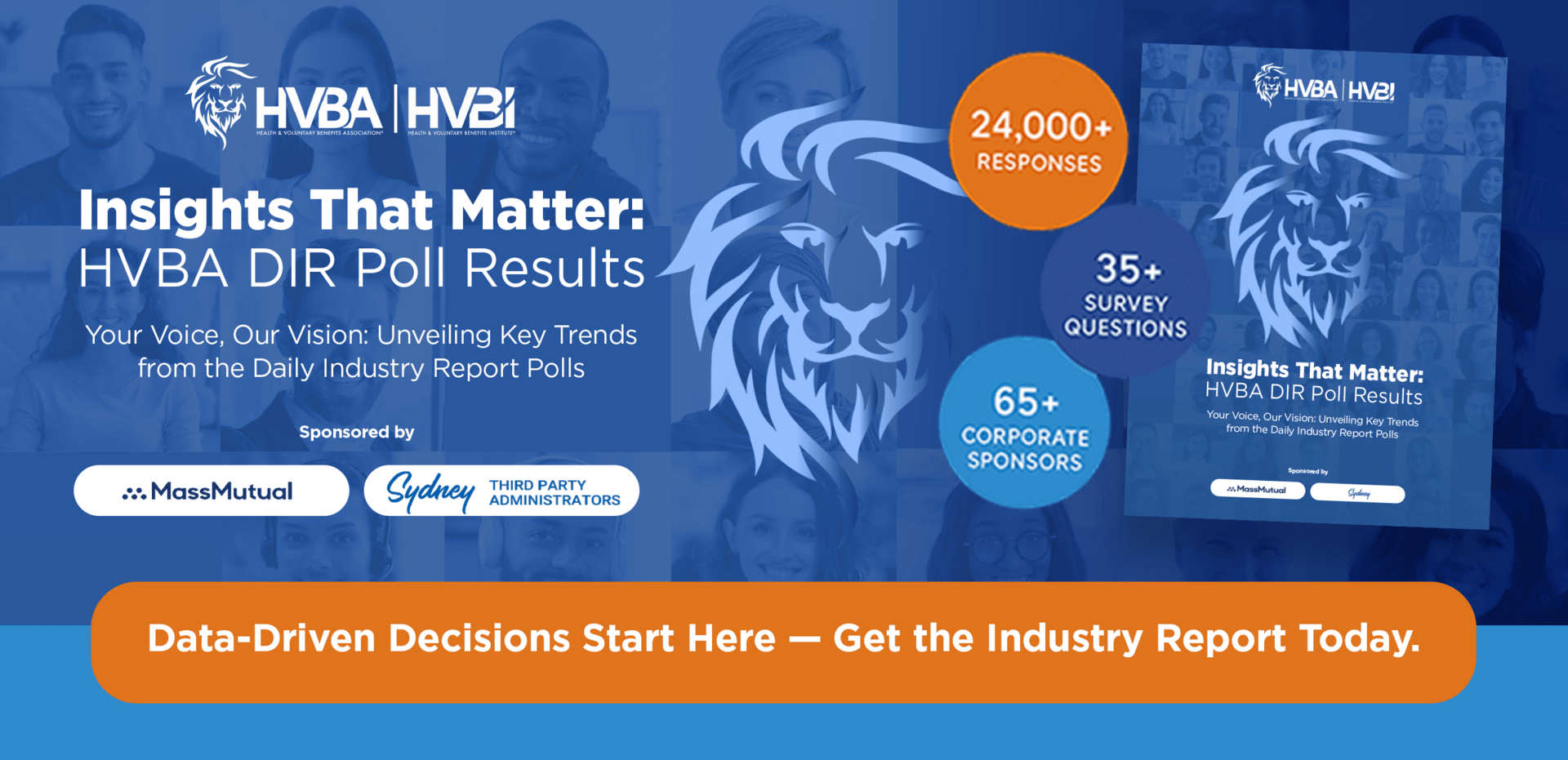- Daily Industry Report
- Posts
- Daily Industry Report - July 23
Daily Industry Report - July 23

Your summary of the Voluntary and Healthcare Industry’s most relevant and breaking news; brought to you by the Health & Voluntary Benefits Association®
Jake Velie, CPT | Robert S. Shestack, CCSS, CVBS, CFF |
Republicans are ready to revive stalled health care legislation. Dems want the GOP to pay a price.
By Benjamin Guggenheim - Republicans are eyeing an opportunity to enact a bipartisan health package by the end of the year, but Democrats aren’t exactly in a deal-making mood. With the dust barely settled after enacting their party-line domestic policy megabill, GOP lawmakers on the Senate Finance, House Ways and Means and House Energy and Commerce committees are hoping they’ll have another shot this year at making policy changes to drug pricing long sought by both parties. Read Full Article…
HVBA Article Summary
Renewed bipartisan negotiations on health care hinge on a major sticking point: Democrats insist that any talks must include extending enhanced Affordable Care Act (ACA) tax credits, which currently make insurance more affordable for millions of middle- and upper-income Americans. Republicans, particularly House leaders, are reluctant to agree, citing the $383 billion estimated cost of a permanent extension and concerns that the subsidies disproportionately benefit higher earners and inflate insurance premiums.
Both parties support certain bipartisan health measures but remain divided on priorities: Lawmakers across the aisle back initiatives like reforming pharmacy benefit managers (PBMs) to lower drug costs, expanding Medicare coverage for weight loss drugs such as Wegovy and Zepbound, and reauthorizing federal programs for free breast cancer screenings for underserved women. Despite this common ground, deep disagreements over recent Medicaid cuts and the future of ACA subsidies threaten to stall or derail any comprehensive health package.
The outcome will test bipartisan cooperation in Trump’s second term: After Republicans pushed through a sweeping “megabill” that included the largest Medicaid cuts in history and billions in program funding reductions, both parties face a key test of whether they can still collaborate on health care reforms. The resolution of ACA subsidy extensions, PBM reforms, and other provisions will determine whether a bipartisan health package moves forward or whether partisan gridlock continues.
HVBA Poll Question - Please share your insightsShould A&H carriers provide a 1099 for Accident, Critical Illness, and Hospital Indemnity claims exceeding $600? |
Our last poll results are in!
59.38%
Of Daily Industry Report readers who participated in our last polling question, when asked, “What strategies do you feel are most effective to gain deeper transparency into — and thereby better manage — total pharmacy spend?” responded with “disaggregate PBM management & functions (formularies, clinical, claims, network access & rebates).”
25% feel the most effective strategies are to “leverage robust data & reporting tools that allow you to analyze costs and trends,” while 9.37% believe it to be “partnering with a smaller, more flexible PBM that will allow formulary customization.” The remaining 6.25% feel that “carve-out specialty vs. traditional drugs, especially the biosimilar drugs,” are the most effective strategies to gain deeper transparency into — and therefore better manage — total pharmacy spend.
Have a poll question you’d like to suggest? Let us know!
Group health care costs may soar 8.5% in 2026, PwC warns
By Allison Bell - The overall increase in the cost of health care, or medical cost trend, could be about 8.5% in 2026, according to a new report from analysts at PwC. The new cost trend projection is about the same as what the PwC analysts have been seeing in the U.S. group health market this year. Read Full Article… (Subscription required)
HVBA Article Summary
Rising Medical Cost Trends for 2025: Analysts’ expectations of limiting the 2025 medical cost trend to 8% have not been met, with factors such as potential reductions in federal Medicaid and ACA subsidies threatening to increase uncompensated hospital care and push hospital rates higher in contract negotiations.
Potential Federal Policy Impacts on Employer Costs: Proposed federal actions, including possible tariffs on imported drugs and medical devices, could further increase employer health plan spending by raising supply costs and shifting additional financial burdens onto insurers and employers.
Emerging Cost Pressures from High-Priced Therapies: Expensive gene and cell therapies, such as Lyfgenia ($3.1 million) and Elevidys ($3.2 million), are becoming major cost drivers, with current limited use due to safety and payer concerns but the potential for widespread adoption as clinical evidence and confidence grow.
Hospitals scoop up physician practices, driving prices up
By Tina Reed - Hospitals are steadily buying small physician practices and, in the process, driving up the price of care, a new National Bureau of Economic Research study shows. Why it matters: It's the latest evidence of consolidation in health care that's left more than three-quarters of U.S. doctors employed by health systems or corporations. Read Full Article…
HVBA Article Summary
Acceleration of Physician Practice Consolidation: Between 2008 and 2016, hospital ownership of physician practices increased by 71.5%, with nearly half (47.2%) of practices hospital-owned by 2016. This consolidation, driven by declining reimbursements, rising administrative costs, and pandemic-related financial pressures, has contributed to the decline of independent practices.
Rising Healthcare Prices Following Acquisitions: Research shows physician prices rise an average of 15.1% within two years of hospital acquisitions, including specific increases like a 3.3% rise in labor and delivery costs, without corresponding improvements in care quality. These numerous small-scale deals often avoid federal antitrust scrutiny despite their collective market impact.
Debate Over Impacts and Regulatory Solutions: Critics warn consolidation raises costs and reduces competition, while the American Hospital Association argues partnerships stabilize practices and improve infrastructure, particularly in rural areas. Proposed solutions include site-neutral payments and requiring merging entities to demonstrate public benefit before deals proceed.
Surprise Medical Bills Were Supposed To Be a Thing of the Past. Surprise — They’re Not.
By Elisabeth Rosenthal - Last year in Massachusetts, after finding lumps in her breast, Jessica Chen went to Lowell General Hospital-Saints Campus, part of Tufts Medicine, for a mammogram and sonogram. Before the screenings, she asked the hospital for the estimated patient responsibility for the bill using her insurance, Tufts Health Plan. Her portion, she was told, would be $359 — and she paid it. She was more than a little surprised weeks later to receive a bill asking her to pay an additional $1,677.51. “I was already trying to stomach $359, and this was many times higher,” Chen, a physician assistant, told me. Read Full Article…
HVBA Article Summary
Limited Scope of the No Surprises Act: While the No Surprises Act successfully protects insured patients from certain types of unexpected out-of-network charges—primarily those involving emergency care or unintentional out-of-network services—it does not cover a wide range of other surprise medical bills, such as unexpected charges from in-network providers or services lacking clear cost estimates.
Implementation Gaps Reduce Effectiveness: Provisions in the law intended to provide cost transparency for insured patients—such as requiring good-faith estimates—have not yet been implemented, leaving many individuals vulnerable to unexpected and confusing charges, even when they believe they are following all necessary procedures.
Persistent Patient Frustration and Confusion: Many insured patients continue to receive high and unanticipated medical bills despite the law, often facing unclear explanations and complex billing systems. This ongoing issue highlights a significant gap between the law's intentions and the actual patient experience, fueling calls for broader reforms and enforcement.
Employees are paying out-of-pocket for the benefits they're not getting at work
By Paola Peralta - Over the last few years, organizations have boasted their efforts to invest in broader, more inclusive benefits. So why are employees still looking for — and even paying for — benefits elsewhere? Fifty-eight percent of employees have paid out-of-pocket for tools or services they wish their employer provided, according to a new survey from HR employee software provider Inclusively, with the majority seeking more productivity tools and mental health support. Read Full Article… (Subscription required)
HVBA Article Summary
Benefit leaders risk losing talent due to a disconnect between workforce needs and current offerings: Many employees remain unaware of or disengaged from the benefits available to them, even as companies spend heavily on programs that end up underutilized. This gap not only undermines productivity and retention but also leaves organizations vulnerable to losing employees to competitors who offer more proactive, personalized benefits strategies.
Traditional feedback tools fall short in understanding employee engagement with benefits: Relying solely on annual surveys and enrollment data fails to capture how employees truly interact with their benefits. By using tools that track daily behaviors—such as portal searches, keyword trends, and real-time engagement—leaders can uncover whether low utilization stems from poor communication, accessibility challenges, or mismatched offerings.
Personalized, data-driven benefit strategies are crucial for future workforce success: Companies that aggregate daily engagement insights to tailor and improve their benefits will not only foster loyalty and satisfaction among current employees but also position themselves as attractive destinations for younger talent, who increasingly expect holistic, flexible support from their employers.
'Hard to know what is going to happen': Big Pharmas put brave face on looming tariff threat
By James Waldron - The opening salvo of second-quarter earnings calls this week came against President Donald Trump’s renewed calls for a tariff on pharmaceuticals. The long-threatened tariffs will arrive “probably at the end of the month,” the president suggested Tuesday. “We’re going to start off with a low tariff and give the pharmaceutical companies a year or so to build, and then we’re going to make it a very high tariff,” Trump added. Read Full Article…
HVBA Article Summary
Johnson & Johnson emphasized the benefits of recent U.S. tax policies while downplaying tariff concerns: CEO Joaquin Duato credited the new tax framework for enabling the company’s $55 billion investment commitment in the U.S. over the next four years, aimed at ultimately manufacturing all medicines for U.S. consumption domestically. While tariffs remain uncertain, J&J said its projected impact for 2025 is now $200 million—half of its earlier $400 million estimate—with effects limited to its MedTech division.
J&J plans to use the reduced tariff burden to accelerate growth initiatives: With the updated tariff estimate, CFO Joseph Wolk explained the company intends to reinvest the difference to speed up development within its pipeline, expand indications for existing therapies, and support the launch of new products expected to reach the market soon. The company noted it will continue monitoring longer-term tariff risks but remains focused on growth and innovation despite trade uncertainty.
Novartis warned of a “significant” potential hit from proposed pharmaceutical tariffs but is working to adapt: CEO Vas Narasimhan said the company might struggle to meet the 12–18 month timeline referenced by the administration for moving production to the U.S., noting that most medicines require three to four years to shift manufacturing fully. Novartis is attempting to accelerate this process, maintain sufficient U.S. inventory, and engage with the government to demonstrate its ongoing investments, with hopes of mitigating potential tariff impacts depending on how the final policies are structured.

You Are When You Eat: Microbiome Rhythm and Metabolic Health
By Caitlin Taylor So - You are when you eat? Perhaps. Similar to circadian rhythms that help regulate when we naturally fall asleep and wake up, microbial rhythms in our gut are naturally active at certain times of the day to help regulate our digestion. Researchers from UC San Diego sought out to track these microbial rhythms to determine whether aligning the times we eat to our active/wake phases instead of when we're supposed to be sleeping can bolster our metabolic health. This alignment is known as time-restricted feeding (TRF). Read Full Article…
HVBA Article Summary
Time-Restricted Feeding (TRF) Improves Metabolic Health in Mice: Mice on a high-fat diet confined to an 8-hour nighttime feeding window showed protection against metabolic dysfunctions (such as insulin resistance and inflammation) compared to mice with unrestricted access to the same diet, highlighting the potential influence of eating schedules on metabolic health.
Real-Time Microbial Activity Revealed by Metatranscriptomics: The study utilized metatranscriptomics to observe microbial gene activity in real time, providing a more detailed understanding of gut microbiome rhythms and functions than traditional metagenomics, which only identifies gene presence.
Engineered Gut Bacteria Mimic TRF Benefits Independently: Researchers engineered a strain of gut bacteria to express a bile salt hydrolase (BSH) gene found in Dubosiella newyorkensis, which reproduced many of TRF’s metabolic benefits without dietary restrictions—suggesting a possible therapeutic approach, though further human-relevant studies are needed.







